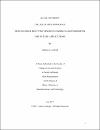NEW FLEXIBLE POLYVINYLIDENE FLUORIDE NANOCOMPOSITES FOR FUTURE APPLICATIONS
| Advisor | Al-Maadeed, Mariam |
| Author | Alsaygh, Aisha Nagi |
| Available date | 2017-03-05T10:35:24Z |
| Publication Date | 2017 |
| Abstract | In this work, we report novel flexible polyvinylidene fluoride (PVDF) hybrid pressure sensors with good mechanical properties. Hybrid combinations of reduced graphene oxide (rGO) with different nano metal oxides -titanium nanolayer (TNL), iron oxide (FeO), and zinc oxide (ZnO)- in PVDF matrix were prepared by solution casting method. In addition to the pressure sensing and vapor sensing properties, the thermal, mechanical, electrical, and dielectric characteristics of the materials are studied. PVDF/rGO (2.5 wt.%)-TNL (2.5 wt.%) hybrid composite showed 2 and 3.6 times enhancement, respectively in tensile strength and Young’s modulus compared to the neat PVDF. The dielectric constant for PVDF/rGO-TNL at 100 Hz was 3.6 times higher than neat PVDF. In pressure sensing, the additives in the matrix increased the sensitivity by 333.46% at 5 kPa and 200.7% at 10.7 kPa and 246.7% at 17.6 kPa compared to PVDF/TNL (5 wt.%). The hybrid composite also exhibited good sensing ability towards the vapors of acetone, tetrahydrofuran (THF), and dimethylformamide (DMF) respectively 1.8, 2.5 and 2 times higher than PVDF/TNL. PVDF/rGO (2.5 wt.%)-FeO (2.5 wt.%) hybrid composite showed 1.3 and 13.8 times enhancement in tensile strength and Young’s modulus respectively, compared to neat PVDF. The dielectric constant at 100 Hz was 1.87 times higher than the pure polymer. In pressure sensing, the sensitivity increased by 41% at 5 kPa, 24.8% at 10.7 kPa and 30.3% at 17.6 kPa compared to PVDF/FeO (5 wt.%). PVDF/rGO-FeO also exhibited good vapor sensing towards acetone, THF, and DMF respectively 1.2, 1.24 and 1.4 times higher than the PVDF/FeO. For PVDF/rGO (2.5 wt.%)-ZnO (2.5 wt.%) hybrid composite, the enhancement in tensile strength and Young’s modulus was 1.98 and 14 times respectively higher than the PVDF. Its dielectric constant at 100 Hz was 1.6 times higher compared to PVDF. In pressure sensing, the sensitivity increased by 167.6% at 5 kPa, 657% at 10.7 kPa and 1066.6% at 17.6 kPa compared to PVDF/ZnO (5 wt.%). PVDF/rGO-ZnO also exhibited good vapor sensing towards acetone, THF, and DMF respectively 1.76, 2.6 and 1.89 times higher than PVDF/ZnO. It was found that PVDF/rGO-FeO possesses the best performance to detect Acetone asn PVDF/rGO-ZnO to detect THF. PVDF/rGO-ZnO and PVDF/rGO-FeO showed the same performance to detect DMF, thus suggesting the future fabrication of electronic nose or e-nose to distinguish polar and non-polar solvents with these polymer nanocomposites. |
| Sponsor | QNRF for providing some financial support through the research grant NPRP 6-282-2-119. |
| Language | en |
| Subject | polymer pressure sensor POLYVINYLIDENE FLUORIDE NANOCOMPOSITES PVDF vapor sensor Education |
| Type | Master Thesis |
| Department | Materials Science & Technology |
Files in this item
This item appears in the following Collection(s)
-
Materials Science & Technology [55 items ]


